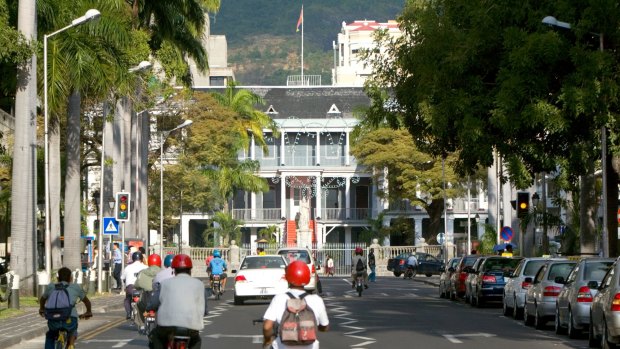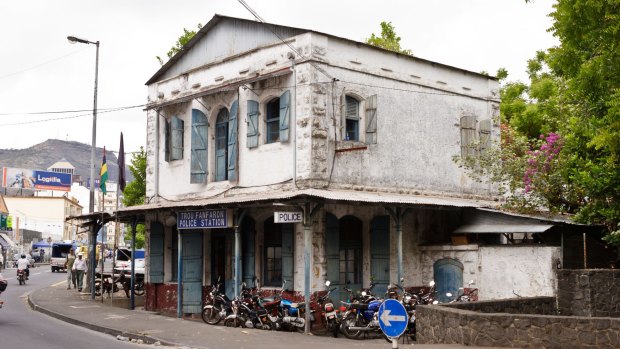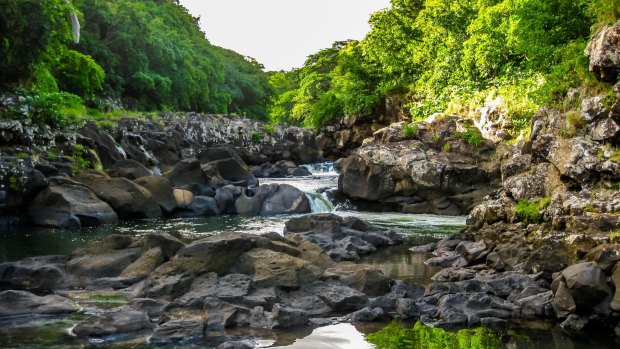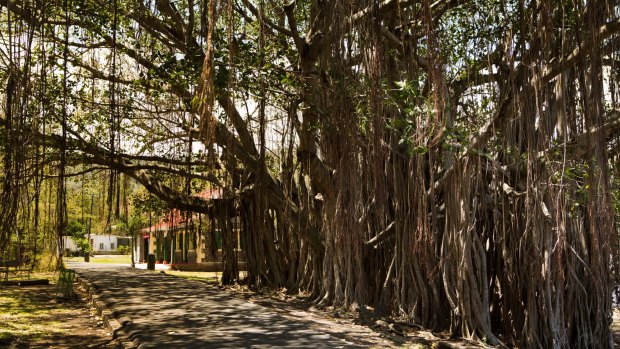By Elspeth Callender

A scooter gives you the freedom to travel at your own pace.Credit: Alamy
Saturday afternoon races are held in the Mauritian capital Port Louis at a track owned by the oldest horse-racing club in the southern hemisphere. I'd set my sights on riding there astride my own trusty steed.
"One helmet or two?" asks Kavi when he arrives at reception. Outside, the rental scooter's fairings gleam in the bright sunlight.
The west coast road south of Grand Baie swings past palm-treed public beaches, fish shops and Indian Ocean views in the direction of Madagascar – more than 1000 kilometres away – then veers inland through sugar cane plantations to meet Port Louis' congested outskirts.

The Trou Fanfaron Police Station, Port Louis, Mauritius. Credit: Alamy
In the centre of this post-colonial seaside city are concrete buildings on cobbled streets, dilapidated wooden cottages on asphalt roads, slave-built stone structures, hennaed beards and the occasional sari, hole-in-the-wall roti joints, enormous tropical trees and serene pockets of green.
Scooters, more than motorbikes, have a manoeuvrability suited to busy city traffic. And, with an open-face helmet, I miss nothing of the sights, sounds, smells, sun and moderate exhaust smog.
The laminated map from Kavi has limited city detail so I ask a local for directions to the racecourse and arrive in just "trois tours". Three turns. The island speaks Mauritian Creole, French and English but favours the first two.

Black River Gorges National Park, Mauritius.Credit: Alamy
At Champ de Mars, the racetrack now celebrating more than "200 years of passion", I leave the scooter on the street having been warned about getting hemmed in at the bike parking lawn. Trackside, other riders keep helmets on for convenience and, in the midday heat, I snack on dahl puri and watch horses race and people gamble.
My lunch destination is just a few kilometres away and the police conveniently pull me over just when I need directional advice. As Kavi had predicted, they want to check my helmet, rego papers and driver's licence as part of a crackdown on poorly maintained bikes.
"Super and unleaded are the same here," Kavi had also explained. Both words refer to unleaded, for which it's cheaper to pay cash. He had advised taking roundabouts at less than 40km/h to avoid the negative attention of police and had been very relaxed about when I should drop back the bike.

Banyan trees curtaining road, Mauritius.Credit: Alamy
It was much cooler at Eureka, a sugar plantation homestead built in a moist mountain shadow in 1830.
"Is it fast to Quatre Borne from here?" I ask Minta, the woman who has led the house tour. Mauritius is only 61 kilometres from top to bottom and just over 2000 square kilometres in area, but a road system built across a young volcanic island with some well populated pockets means travel times can be hard to predict. She grins.
"If you're fast, then it'll be fast."
I whizz to the central plateau and then crawl through Quatre Borne behind a colourful bus, with a rear slogan "Catch me if you can", past temples, mosques, markets and snack shops selling home-made Indian sweets. Mauritius has three other towns and around 130 villages.
Mauritians drive on the left, but otherwise behave quite differently on the road. As always, there's method in the apparent madness.
Maintaining a steady speed is key, as is watching for obstacles on the other side of the road, so it's no surprise when oncoming traffic swings across the centre line to miss something on their side.
I own my lane and keep my line, only deviating when I am sure nobody is in my unfamiliarly small personal road space. It turns out no one likes to stop and you are not obliged to for pedestrians, except when they step out.
Later in the week, I explore the island's lusher, cooler, less peopled south where roads ribbon under massive banyan trees, trimmed like fringes over the bitumen, and curve past historic sugar factories. I visit Black River Gorges National Park, tea plantation Bois Cheri and ride the awesome hairpin bend at Baie du Cap on the way to the island's most western peninsula of Le Morne.
One morning, on the way to meet Vertical World for canyoning, I get lost far from my destination of Henrietta. As I pull out my map, another scooter stops beside me. The guy rides miles out of his way to get me on the right track but refuses my offer of money for "super".
TRIP NOTES
MORE INFORMATION
GETTING THERE
Air Mauritius flies from Sydney and Melbourne (via Perth) to Sir Seewoosagur Ramgoolan International Airport. See airmauritius.com.
STAYING THERE
Merville Beach Hotel, Grand Baie, has rooms from $130 a night. See mervillebeach.com. Outrigger Mauritius Beach Resort, Bel Ombre, has rooms from $315 a night. See www.outriggermauritius.com.
RIDING THERE
Organise scooter hire the day before you need it; your hotel or host will contact a local provider. Cost is around $35 a day and excess can be up to 10 times that. Previous riding experience is strongly recommended.
Elspeth Callender was a guest of the Mauritian Tourism Promotion Authority.
Sign up for the Traveller Deals newsletter
Get exclusive travel deals delivered straight to your inbox. Sign up now.